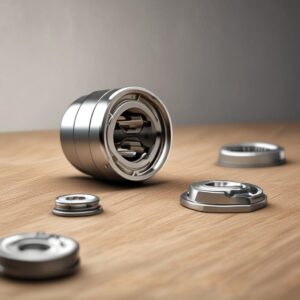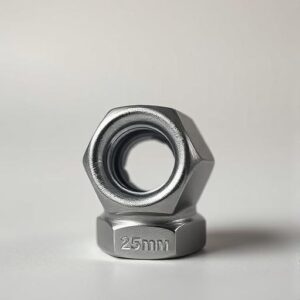Owning a Dodge Challenger means you’re part of a legacy of raw power and performance. Whether you’re a daily driver or a weekend warrior, knowing the correct lug nut socket size is essential for safe and efficient wheel maintenance. Using the wrong size can strip lug nuts, damage wheels, or even compromise safety while driving. In this guide, we’ll break down the standard socket sizes for 2015-2023 Dodge Challenger models, explain why accuracy matters, and provide practical tips for DIY maintenance.
Step-by-Step Process
Identify Lug Nut Type
Check if lug nuts are conical, flat, or spline.
Measure Lug Nut Size
Use a caliper or ruler to measure the diameter.
Verify Socket Fit
Ensure the socket matches the lug nut size exactly.
Check Socket Depth
Confirm the socket depth accommodates the lug nut.
Test Socket Compatibility
Test the socket on the lug nut before use.
Process infographic for Dodge Challenger Lug Nut Socket Size

What is the Standard Socket Size for 2015-2023 Dodge Challenger Lug Nuts?
Common Sizes Across Model Years
Most Dodge Challenger models from 2015 to 2023 use either 12mm or 13mm lug nuts, depending on the trim and wheel type. For example, standard trims often use 12mm, while performance models like the R/T, SRT, or Scat Pack may require 13mm sockets. Always check your owner’s manual to confirm, as variations exist. Modern vehicles predominantly use metric sizes for precision and standardization, ensuring consistency across global manufacturing.
SAE vs. Metric: Which Socket Should You Use?
The Dodge Challenger’s lug nuts are metric, so a 12mm socket (0.472 inches) or 13mm socket (0.512 inches) is necessary. While SAE equivalents like 15/32″ or 1/2″ may seem close, they are not interchangeable. Using the wrong system risks stripping threads or damaging the lug nut. Hybrid socket sets that include both metric and SAE sizes are a practical investment for dual-system vehicles.
Why the Correct Socket Size Matters for Your Dodge Challenger
Avoid Damaging Lug Nuts or Wheels
Using an undersized or oversized socket can strip lug nuts, bend wheel studs, or round off the hexagonal faces, making future removals difficult. High-torque applications, like those needed for performance models, demand precise fitment to prevent wheel loosening or catastrophic failure while driving.
Torque Specifications and Socket Fit
Improper socket size affects torque application. Dodge Challengers typically require 80-120 ft-lbs of torque, depending on the wheel type. A loose fit can lead to inconsistent tightening, while a tight fit risks over-torquing. Always use a torque wrench to achieve the manufacturer’s specifications.
Differences Between Factory and Aftermarket Wheels
Aftermarket wheels may use non-standard lug nut sizes or configurations (e.g., cone-shaped nuts). Verify the socket size with the wheel manufacturer or dealer to avoid mismatches. Factory wheels usually adhere to Dodge’s specifications, but aftermarket modifications can introduce variability.
Tools and Techniques for Working with Dodge Challenger Lug Nuts
Socket Requirements for 2015-2023 Models
Opt for a 12mm or 13mm deep socket to accommodate the wheel studs fully. A breaker bar helps loosen stubborn lug nuts, while a torque wrench ensures proper tightening. A 6-point socket is preferable to a 12-point socket, as it reduces the risk of rounding off the lug nut.
Step-by-Step Guide to Removing and Installing Lug Nuts
To remove lug nuts, park on a flat surface, engage the parking brake, and loosen nuts in a star pattern to avoid warping the wheel. For installation, tighten in the same sequence with a torque wrench. Apply penetrating oil to seized lug nuts and allow it to sit before attempting removal.
Common Mistakes to Avoid
- Using the wrong socket size can strip threads or damage the lug nut.
- Over-tightening without a torque wrench risks wheel damage.
- Skipping anti-seize lubricant on threads can cause future removal difficulties.
How to Confirm Your Dodge Challenger’s Lug Nut Socket Size
Check the Owner’s Manual or Vehicle Documentation
Refer to the “Tire and Wheel” section of your owner’s manual for exact specifications. Note any model-year-specific details, such as differences between rear-wheel and all-wheel-drive configurations.
Locate the Size on the Vehicle
Check the tire information placard on the driver’s side door jamb. This sticker often lists lug nut size, torque specifications, and recommended tire pressures.
Consult a Professional or Dealer
If markings are unclear or you’ve installed aftermarket wheels, seek assistance from a mechanic or dealership. They can verify sizes and ensure compatibility with your vehicle’s specifications.

Frequently Asked Questions (FAQ)
1. What is the most common socket size for a 2020 Dodge Challenger?
Most 2020 Challengers use 12mm or 13mm sockets, but confirm with the owner’s manual for your specific trim.
2. Can I use a 1/2″ socket instead of 13mm for my Challenger?
No—SAE and metric sizes are not interchangeable. Using the wrong size can damage lug nuts or wheel studs.
3. Why do my lug nuts require a deep socket?
Deep sockets reach over the wheel studs, providing better access and leverage for removal.

4. How do I know if my socket size is correct?
The socket should fit snugly on the lug nut without wobbling. Test it on a loose nut first.
5. Do all Dodge Challenger models use the same lug nut size?
Most use 12mm or 13mm, but variations exist for performance trims or model years.
Conclusion: Ensure Safety and Precision with the Right Socket Size
Using the correct lug nut socket size is critical for your Dodge Challenger’s safety and longevity. Always consult the owner’s manual or a trusted professional if in doubt. Remember to use a torque wrench and follow manufacturer guidelines for optimal results. With the right tools and knowledge, you’ll keep your Challenger performing at its best for years to come.




